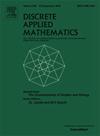在符号可逆图上
IF 1
3区 数学
Q3 MATHEMATICS, APPLIED
引用次数: 0
摘要
设G是一个图,a是它的邻接矩阵。若图G的邻接矩阵A是可逆的,则图G是可逆的,且图G的逆是邻接矩阵A−1的加权图。有符号图(G,σ)是具有特殊权函数σ:E(G)→{−1,1}的加权图。如果一个图的逆是一个有符号的图,那么这个图就是符号可逆的。符号可逆图总是单模的。图的逆具有有趣的组合兴趣。本文研究了图的逆,给出了符号可逆图的组合描述,为符号可逆图的刻画提供了一个工具。作为应用,我们完全刻画了具有唯一完美匹配的符号可逆二部图,以及循环秩最多为2的符号可逆图。作为这些表征的必然结果,一些关于树(Buckley, Doty和Harary, 1982年)和具有唯一完美匹配的单环图(Kalita和Sarma, 2022年)的早期结果可以直接得到。本文章由计算机程序翻译,如有差异,请以英文原文为准。
On sign-invertible graphs
Let be a graph and be its adjacency matrix. A graph is invertible if its adjacency matrix is invertible and the inverse of is a weighted graph with adjacency matrix . A signed graph is a weighted graph with a special weight function . A graph is sign-invertible if its inverse is a signed graph. A sign-invertible graph is always unimodular. The inverses of graphs have interesting combinatorial interests. In this paper, we study inverses of graphs and provide a combinatorial description for sign-invertible graphs, which provides a tool to characterize sign-invertible graphs. As applications, we completely characterize sign-invertible bipartite graphs with a unique perfect matching, and sign-invertible graphs with cycle rank at most two. As corollaries of these characterizations, some early results on trees (Buckley, Doty and Harary in 1982) and unicyclic graphs with a unique perfect matching (Kalita and Sarma in 2022) follow directly.
求助全文
通过发布文献求助,成功后即可免费获取论文全文。
去求助
来源期刊

Discrete Applied Mathematics
数学-应用数学
CiteScore
2.30
自引率
9.10%
发文量
422
审稿时长
4.5 months
期刊介绍:
The aim of Discrete Applied Mathematics is to bring together research papers in different areas of algorithmic and applicable discrete mathematics as well as applications of combinatorial mathematics to informatics and various areas of science and technology. Contributions presented to the journal can be research papers, short notes, surveys, and possibly research problems. The "Communications" section will be devoted to the fastest possible publication of recent research results that are checked and recommended for publication by a member of the Editorial Board. The journal will also publish a limited number of book announcements as well as proceedings of conferences. These proceedings will be fully refereed and adhere to the normal standards of the journal.
Potential authors are advised to view the journal and the open calls-for-papers of special issues before submitting their manuscripts. Only high-quality, original work that is within the scope of the journal or the targeted special issue will be considered.
 求助内容:
求助内容: 应助结果提醒方式:
应助结果提醒方式:


